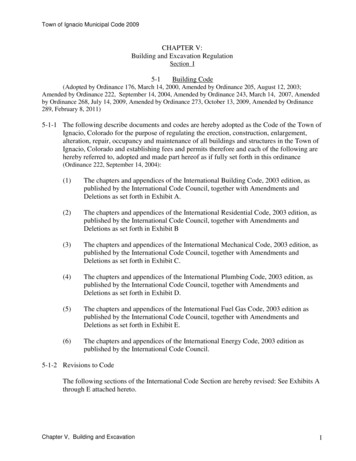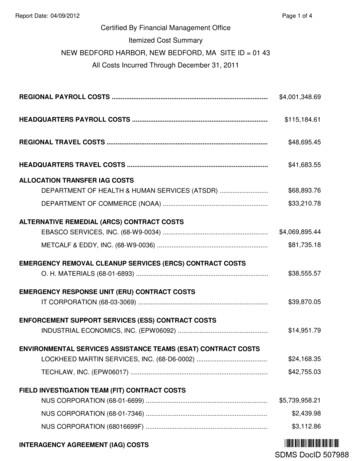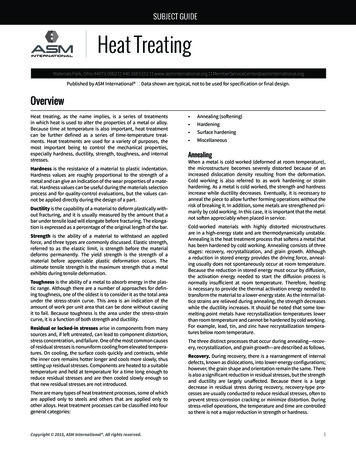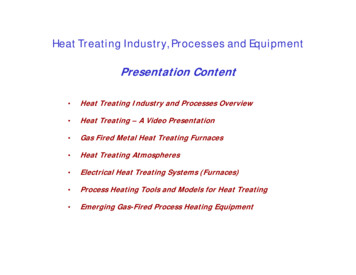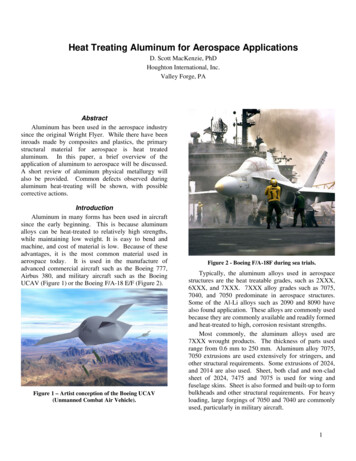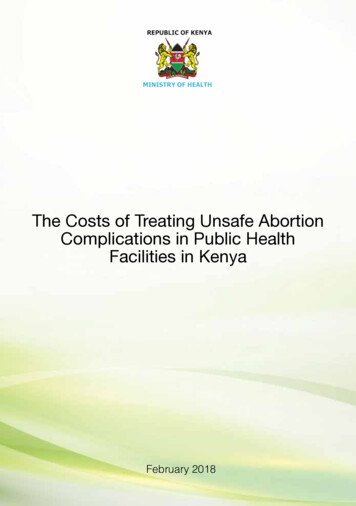
Transcription
The Costs of Treating Unsafe AbortionComplications in Public HealthFacilities in KenyaFebruary 2018
The Costs of Treating UnsafeAbortion Complications in PublicHealth Facilities in KenyaFebruary 2018
Table of ContentsAcknowledgments vForeword viiList of Acronyms viiiExecutive Summary ixBackground 1Study Methodology 2Ethical Approval 7Findings 7Per-Case Labor Costs7Per-Case Supply Costs8Total Per-Case Costs9Cost Variations by Level of Facility and Regions10Annual Caseload and Costs of Treating Unsafe AbortionComplications in Kenyan Public Health Facilities12Discussion 15Study Limitations 17Conclusions and Policy Recommendations18References 19Appendices 22ivThe Cost of Treating Complications of Unsafe Abortion in Public Health Facilities in Kenya
AcknowledgmentsThis report is based on research that was generously supported by theWilliam and Flora Hewlett Foundation (Grants#2013-9285 and 2012-7612).The study team is indebted to the Ministry of Health (MoH), Kenya, as wellas the Office of the Director of Medical Services Dr. Jackson K. KiokoOGW, MoH, Kenya, for supporting this research. We also thank all thehealth care providers who participated in the research and furnished thedata used in the report. Our gratitude goes to Lawrence Ikamari, MichaelVlassoff, Djesika Amendah, Ann Kihara, Naisola Likimani, Guyo Jadelsa,Joachim Osur, John Nyamu, Wangui Muthigani, Caroline Odula, SimonMueke, Faustina Fynn-Nyame, and Nehemiah Kimathi for finding the timeto review this report and attend meetings to appraise the study results.Core funding support provided to APHRC by Sida (Grant # 54100029) alsoenabled APHRC staff to develop the study and prepare this report.The Cost of Treating Complications of Unsafe Abortion in Public Health Facilities in Kenyav
Study TeamAfrican Population and Health Research CenterChimaraoke IzugbaraEstelle SidzeMichael MutuaCarolyne EgesaMaharouf OyololaStephen MulupiIpasHailemichael GebreselassieMaribel Amor Brana ManiboJanie BensonReport Citation:Ministry of Health, African Population and Health Research Center andIpas, 2018. The Costs of Treating Unsafe Abortion Complications in PublicHealth Facilities in Kenya. Nairobi, APHRC, Kenya.viThe Cost of Treating Complications of Unsafe Abortion in Public Health Facilities in Kenya
ForewordDespite improvements in several key health indicators over the pastdecades, maternal mortality and morbidity have remained high in Kenya.A significant proportion of these deaths and morbidities is driven bycomplications of unsafe abortion.A nationwide study on the incidence of abortion in Kenya conducted by theAfrican Population and Health Research Center (APHRC), in collaborationwith the Ministry of Health (MoH) and other partners, revealed that abouthalf a million induced abortions occurred in the country in 2012. Most ofthese abortions were unsafe and resulted in various complications. Thestudy also revealed that most women with complications from unsafeabortion are treated in public health facilities, exerting pressure on scarcehealth system resources.In this report, we present national and other estimates of the direct costs oftreating complications of unsafe abortion in public health facilities in Kenya.The report furnishes up-to-date and critical evidence to guide interventionsto reduce the costs of unsafe abortion in the country and improve women’saccess to high quality, comprehensive post-abortion care.The evidence in this report shows that the costs of managing complicationsof unsafe abortion in public health facilities in Kenya are substantial. Manycomplications from unsafe abortion are emergencies and require extendedhospital stays, intensive care, and attendance by highly skilled healthproviders. In diverting scarce human and financial resources within thepublic health system, treating these complications clearly hinders efforts toprovide good maternal health care.Taken together, the report findings provide a rationale for key stakeholdersin the field of women’s health and rights in Kenya to work together toaddress unsafe abortion and support the development and delivery ofinnovative interventions to promote women’s wellbeing, while also impellinga more concerted effort to improve access to family planning for all womenacross the country.Dr. Kioko Jackson K., OGW, MBSDirector of Medical ServicesMinistry of HealthGovernment of KenyaThe Cost of Treating Complications of Unsafe Abortion in Public Health Facilities in Kenyavii
List of AcronymsviiiAPHRCAfrican Population and Health Research CenterD&CDilation and curettageEVAElectric vacuum aspirationHFSHealth Facility SurveyKEMRIKenya Medical Research InstituteMPACMisoprostol for post-Abortion careMVAManual vacuum aspirationPACPost-abortion carePMSProspective Morbidity SurveyWHOWorld Health OrganizationThe Cost of Treating Complications of Unsafe Abortion in Public Health Facilities in Kenya
Executive SummaryUnsafe abortion—the termination of pregnancy either by persons lackingthe necessary skills or in an environment lacking the minimal medicalstandards, or both—is a leading cause of maternal mortality and morbidityglobally. In addition to immediate complications such as organ failure andsepsis which sometimes result in death, unsafe abortion often has severallater health consequences, including secondary infertility and chronicreproductive tract infections.Research indicates that nearly half a million induced abortions—unsafefor the most part—occurred in Kenya in 2012, resulting in different formsand intensities of medical complications. Most of these complicationswere treated in public health facilities. Currently, limited up-to-date dataexist on the costs of these interventions, which prevents health systemadministrators from being able to accurately budget and allocate humanresources.This report presents findings of a national study on estimated costs basedon reported cases, by severity of complications. The study relies onnationally representative primary and secondary data drawn from a varietyof authoritative sources: individual and panel interviews with a sample ofcurrent, knowledgeable and experienced providers of post-abortion carein Kenyan public facilities; data on the direct costs of all key inputs (healthcare provider time, drugs, and supplies) needed to provide completetreatment to one patient; and secondary data on women hospitalized inpublic health facilities for complications of induced abortion.Study results show that the financial cost of treating of unsafe abortioncomplications in public health facilities is staggering. On average, to treata woman for complications from an unsafe abortion requires 7.4 hoursof health care personnel time. This time ranged from 5.5 hours for mildcomplications to 6.7 hours for moderate complications, and up to 12.4hours for the treatment of severe complications, involving procedures suchas pelvis abscess drainage or cervical/vaginal tear repair. Most of thesewere time spent by nurses and medical officers.The average cost of a typical treatment stood at 4,943 Kenyan shillings(Ksh) or 58 US dollars (US ) . This cost varied from Ksh 3,264 (US 39) formild complications and Ksh 4,362 (US 52) for moderate complications toKsh 9,133 (US 108) for severe complications.Using an average exchange rate of Ksh 84.56 1US in 2012. tatistics/exchange-rates-21The Cost of Treating Complications of Unsafe Abortion in Public Health Facilities in KenyaMost of these were time spent my nurses and medical officersix
Personnel costs accounted for most of these expenses and ranged fromKsh 1,930 (US 23) for mild cases and Ksh 2,353 (US 28) for moderatecomplications to Ksh 5,653 (US 67) for severe complications. On average,it costs more to treat abortion complications patients in Nairobi (Ksh 7,674/US 91) and Eastern (Ksh 5,390/ US 64) regions than elsewhere in thecountryPersonnel costs accounted for most of these expenses and ranged fromKsh 1,930 (US 23) for mild cases and Ksh 2,353 (US 28) for moderatecomplications to Ksh 5,653 (US 67) for severe complications. On average,it costs more to treat abortion complications patients in Nairobi (Ksh 7,674/US 91) and Eastern (Ksh 5,390/ US 64) regions than elsewhere in thecountry.In 2012, the treatment of unsafe abortion complications cost the publichealth system a total of Ksh 432.7 million (about US 5.1 million) in healthpersonnel salaries and medical supplies. Most was spent in the treatmentof severe medical complications. In 2016, the treatment costs for thesecomplications in public facilities will reach an estimated Ksh 533 million(about US 6.3 million).Addressing unsafe abortion in Kenya requires strengthening governmentalinstitutions and agencies mandated to protect women’s health to implementlife-saving measures within the limits of the law. These measures includepromoting women’s access to quality post-abortion care, includingpost-abortion family planning counseling and improved provision andeducation about family planning. Increasing access for both women andmen to effective contraceptive methods, particularly long-acting reversiblecontraceptives, will also tackle one of the root causes of unsafe abortion.Kenya must also rethink the structure of sexual and reproductive healthcare delivery to ensure both access to, and the availability of, qualityproviders at all levels of care. These measures call for strong political will,strategic planning, and more research.Costs of TreatingUnsafe Abortion ComplicationsIn 2012, KES 433 million was spent in Kenyan public healthfacilities to treat unsafe abortion complicationsThis is a conservative estimate and only measurescosts from women who present with complicationsKES 433 millionKES 533 millionTreatment of unsafe abortioncomplications is projectedto cost the health systemKES 533 millionin 201658%of costs werefor health carepersonnel42%of costs formedicationand othersuppliesxSource: The Costs of Treating Unsafe Abortion Complicationsin Public Health Facilities in Kenya (2018)African Population andHealth Research CenterThe Cost of Treating Complications of Unsafe Abortion in Public Health Facilities in Kenya
BackgroundThe World Health Organization (WHO) [1] defines unsafe abortion as thetermination of pregnancy either by persons lacking the necessary skillsor in an environment lacking the minimal medical standards, or both.Currently, unsafe abortion accounts for 47,000 annual maternal deathsworldwide, with over 90% of these deaths occurring in low- and middleincome countries. Countless other women who undergo unsafe abortionsuffer serious and life-threatening injuries [1]. Unless women can avoidunplanned pregnancies, millions of them risk experiencing an unsafeabortion during their lives, particularly in low- and middle-income countries[1-3].In Kenya, unsafe abortion is a major social and public health problem[4].Recent nationwide research showed that about half a million inducedabortions—unsafe for the most part—occurred in the country in 2012,corresponding to an induced abortion ratio of 30 abortions per 100 livebirths and a rate of 48 abortions per 1,000 women of reproductive age[5]. The study established that most unsafe abortion-related admissionsin Kenya are managed in public health facilities [5]. It also indicated that77% of women who sought post-abortion care (PAC) in Kenyan healthfacilities were treated for moderately severe or severe complications, suchas sepsis, shock, and organ failure [5]. Death due to unsafe abortion is alsocommon in Kenya [5].The management and treatment of complications from unsafe abortionexerts a substantial toll on health system resources [6-16]. Many of thesecomplications are emergencies and require extended hospital stays,intensive care and attendance by highly skilled health providers. Up-todate information on treatment costs has implications for budgeting andresource allocation. Such evidence has the potential to guide interventions,reduce costs to the health system and improve women’s access to highquality comprehensive post-abortion care, counselling, family planningservices and other reproductive health services at all levels of the healthsystem.This study estimates the personnel, medications and medical suppliescosts of treating complications of unsafe abortion in the Kenyan publichealth system. The estimates presented exclude costs for facility utility andspace, referrals, overheads, and other direct and indirect costs to womenand their families.The Cost of Treating Complications of Unsafe Abortion in Public Health Facilities in Kenya1
Study MethodologyData SourcesIn this study, health care personnel, medication, and medical suppliescosts (i.e., direct costs) of treating abortion complications were estimatedusing three data sources.1. Key inputs (i.e. personnel time, drugs, and supplies used forvarious treatment regimens for treating a typical patient)Data were collected through panel discussions with knowledgeable andexperienced post-abortion care providers in public health facilities. Theseproviders were drawn from a nationally representative sample of 128public health facilities that were part of the 2012 Kenya Incidence andComplications of Unsafe Abortion study [5]. All of the levels 4 to 6 publichealth facilities and 67% of the level 2 and level 3 public health facilities thathad participated in the 2012 study were included in the costing study. Thedistribution of the sampled and participating health facilities by region andfacility level is shown in Table 1. A total of 192 providers were recruited,in consultation with the Ministry of Health and based on the providers’experience in post-abortion care (PAC), obstetrics and gynecology;current involvement in PAC service provision in the sampled facilities;and knowledge of clinical regimens and service delivery for treatment ofabortion complications. The distribution of providers participating in thepanels by region, level of facility, cadre, gender, age, education level, andyears of experience in PAC provision is shown in Table 2.Using a modified Delphi survey approach [7], the panelists were presentedwith standardized questionnaires comprising three scenarios of womenpresenting signs and symptoms suggestive of mild, moderate and severeabortion complications (Table 3), and type of patient—out-patient andin-patient. For each scenario, each panelist first individually described,from personal practice at their respective facilities, the usual treatmentprotocol and amount of clinical supplies and medications used, the typesof personnel involved in direct care of a typical patient presenting withcomplications from abortion, and the estimated personnel time ordinarilyspent for each step taken during treatment of a typical case . IndividualThe health care facility level is a description of functionality as defined by the Kenyan Ministry ofHealth. Level 1 is the lowest (primary) level of care while Level 6 is the highest level of health care inKenya, providing sophisticated diagnostics, therapeutic and rehabilitative services.2The time captured only included the interaction time between the health provider and the patient.Waiting time was not considered.32The Cost of Treating Complications of Unsafe Abortion in Public Health Facilities in Kenya
providers were later paired with other providers from the same facility toreview their written estimates jointly and to reach a consensus on all threescenarios. Finally, the providers were grouped into teams from the samefacility level to develop a unified estimate for each of the three scenarios.Data from the group forms were used to estimate the costs for treatingcomplications of abortion by severity.Table 1Participating facilities, by region and levelRegionLevel 6Level 5Level 4Level 3Level robi103105North Eastern0153110Nyanza02117323Rift Valley1295522Western0154414Total212583026128The Cost of Treating Complications of Unsafe Abortion in Public Health Facilities in Kenya3
Table 2Characteristics of panel participants (N 192)CharacteristicsRegionNo. of respondents(Unweighted North Eastern167.0Nyanza3719.7Rift Valley2924.2Western2013.6Level 22742.0Level 33130.3Level 410926.3Level 5221.3Level 630.2OB/Gyn30.6Medical officer50.8Clinical officer4218.2Nurse12271.2Trained midwife54.4Other154.8Male7646.4Female11453.0Not indicated20.6 30 years4622.631-39 years6843.440 years6930.0Not indicated94.1College (middle level)16191.3Degree/Postgraduate224.6Other94.10-4 years10852.55-9 years5023.910 years3020.0Not indicated43.5Total192100.0Level of facilityCadre ‡GenderAgeEducation levelYears of experience as PAC provider‡ Others include: health counselors, family planning counselors and reproductive health officer4The Cost of Treating Complications of Unsafe Abortion in Public Health Facilities in Kenya
Table 3Classification of severity of abortion complicationsClassification1. SevereSigns and symptomsComplications which are or can quickly become life-threatening ifnot treated immediatelyBody temperature of 37.9 COrgan or system failureGeneralized peritonitisPulse 119 beats/minuteEvidence of foreign body or mechanical injurySepsisShock2. ModerateTetanusComplications which are or can quickly become life-threatening ifnot treated immediatelyBody temperature between 37.3–37.9 CAdnexal or abdominal tendernessLocalized peritonitis3. Mild/SimpleOffensive products of conceptionStable conditionSome signs and symptoms of localized infection and/or lightto moderate vaginal bleeding but no sign of life-threateningconditionCases required only one sign or symptom to be included in a particular category (adapted from Jewkes, Fawcus etal. 1997[16] and Jewkes, Gumede et al. 2005[17]; also see APHRC, 2013[4]).2. Direct costs of all key inputs (as used in treatment regimens)Data on direct costs of all key inputs (personnel time, drugs and supplies,and excluding overheads) were computed using information on salariesand essential medicines from the Ministry of Health. These data were usedto estimate the staff and supplies costs for treating each scenario.Staff costs were calculated using 2012 information on average minimumsalary plus allowances by health cadre per year provided by the Ministry ofHealth. The 2012 salary structure for civil servants by job groups was alsoused as an additional source of data [19]. Salaries were converted fromKenyan shillings to US dollars, and then to a per-hour rate. The per-hourrate was calculated based on the assumption that health personnel workeight hours per day for 222 days per year. This translates to a total of 1,776hours per provider, per year. The amount of time each provider spent onall steps involved, from admission to discharge, was multiplied by the unitcost of that provider. For example, eight hours spent by a nurse multipliedby US 2 salary cost per hour US 16 cost for a nurse’s time.Costs of medications and medical supplies were derived using pricesfrom the Kenya Medical Supplies Authority (2013), the Mission for EssentialDrugs and Supplies (2014), and the Management Sciences for HealthThe Cost of Treating Complications of Unsafe Abortion in Public Health Facilities in Kenya5
International Drug Price Indicator Guide (2013). This information wassupplemented by key informant interviews with practicing senior clinicians.The cost of these resources was calculated by multiplying the amount usedby the unit cost of that resource.3. Nationally representative data on women hospitalized for unsafe abortion complicationsThe 2012 Kenya Incidence and Complications of Unsafe Abortion study [4]provided nationally representative data on women hospitalized for unsafeabortion complications, enabling computation of total caseload in publichealth facilities. Caseloads by scenario of complications and treatmentprocedures—manual vacuum aspiration (MVA), dilation & curettage (D&C),misoprostol for post-abortion care (MPAC)—were also computed.Cost Estimation ProceduresNational and regional estimates of the treatment costs were obtained bycombining information on the per-case costs by scenario and the number/proportion of annual cases by scenario, using a multi-step process outlinedin Table 4.Table 4Estimation of national and regional costs of treating unsafe abortioncomplications1Per-case costsFor each scenario, we calculated:Per-case labor costs: provider time in minutes provider unit cost (per-minute salaryrate)Per-case supply costs: quantity of supply used supply unit costPer-case cost of PAC treatment: per-case labor cost per-case supply cost2Number and proportion of annual casesFor each scenario, three indicators were extracted from the 2012 Incidence andComplications ofUnsafe Abortion study [4]:The weighted average annual caseloads (From HFS and PMS)§The proportion of caseloads per scenario (From PMS)§The number of annual cases per scenario: proportion of caseloads per scenario totalannual caseload3Weighted per-case costsWeighted per-case costs weighted per-case labor cost weighted per-case supplycost (including 95% confidence intervals)4Annual costsAnnual costs number of annual cases per scenario x weighted per-casecost per scenario§PMS: Prospective Morbidity Survey; HFS: Health Facility Survey. Data weights, which are the inverse of samplingfractions, were used to adjust the statistics presented to match the distributions of the original population.6The Cost of Treating Complications of Unsafe Abortion in Public Health Facilities in Kenya
Ethical ApprovalThe study protocol was reviewed and approved by the research ethicsboards of the Kenya Medical Research Institute (KEMRI), the Directorate ofMedical Services, Ministry of Health, Kenya, and the University of Nairobi/Kenyatta National Hospital.FindingsPer-Case Labor CostsThe treatment and care of a typical patient presenting with complicationsfrom an unsafe abortion in public facilities in Kenya uses 7.4 hours of healthpersonnel time (Figure 1 & Appendix 1). This time includes 1.5 hours spenton non-medical processes such as registration, room preparation and postprocedure instrument/room cleaning performed by clerks and nurses. Thetotal time spent for treating mild complications is 5.5 hours, and 6.7 hoursfor moderate complications. The treatment of a typical patient presentingwith severe complications from an unsafe abortion takes, on average, 12.4hours.Personnel in public health facilities spend 6.5 hours treating an unsafeabortion patient with MVA. They spend 8.6 hours if the treatment is D&Cand 6.2 hours for procedures performed with medical abortion drugs. Onaverage, 16.0 hours are used to treat a typical patient presenting with severecomplications that require surgical procedures such as pelvic abscessdrainage, cervical/vaginal tear repair, or laparotomy/hysterectomy.In terms of per-case labor costs (Figure 2), the average cost of treatinga typical case of mild complications is Ksh 1,930 (US 23)4. The averagehealth personnel cost for a typical case with moderate complications isKsh 2,353 (US 28). A typical severe case costs about twice as much: Ksh5,653 (US 67).Using an average exchange rate of Ksh 84.56 1US in 2012. tatistics/exchange-rates-2. The same exchange rates is used across.4The Cost of Treating Complications of Unsafe Abortion in Public Health Facilities in Kenya7
Total timeMedical procedures12.4Non-medical re 1Average time (in hours) spent by health personnel per treatment of10.2per scenario of complicationsa typical case of complications of unsafe ent for mildTime4.34.3complications6.76.7Time spent 5.3for moderate Time spent for severecomplicationscomplications1.57.45.9 spent perAverage timecase2.22.21.41.21.2TimeTime spentspent forformildmildcomplicationscomplications10.210.2 2.21.5Time spentspent forfor severesevere AverageAveragetimetime spentspentperperTime spentspent forfor moderatemoderate plicationscaseNumbers are weighted averages within each category presented in the figureFigure 2Average health personnel costs (in Kenyan shillings) for treatment ofa typical case of complications of unsafe abortion, per scenario of nel5,6535,653Total cost1,9301,9301,6461,6462,3532,353Medical personnelCostforfor moderateCost2,353 edical personnel2,8482,8485,653328328293293Cost ,6462,0252,0255,1155,1155,115538538Cost forfor 62,848Average costAveragecost perper casecase2,498Numbers are weighted averages within each of the categories presented in the figureCost for mildcomplicationsCost for moderatecomplicationsPer-Case Supply CostsCost for severecomplications2,4982,498356Average cost per caseMedical supplies are the second-largest contributor to the cost of unsafeabortion treatment (Figure 3 & Appendix 2). The treatment of a typical caseof mild complications uses medical supplies and drugs worth Ksh 1,484(US 18). About Ksh 2,204 (US 26) worth of medical supplies are requiredto treat a typical case of moderate complications. A severe case of unsafeabortion complications that requires uterine evacuation and/or surgicalinterventions uses medicines and medical supplies worth about Ksh 4,663(US 55).8The Cost of Treating Complications of Unsafe Abortion in Public Health Facilities in Kenya
Figure 3Average costs (in Kenyan shillings) of medications and medicalsupplies for treating a typical case of complications from unsafe abortion, perscenario of forfor forfor severesevereCostcomplicationscomplicationsAverage cost perAverageper casecaseTotal Per-Case CostsThe overall average cost of treating a typical case of complications fromunsafe abortion in Kenyan public health facilities is Ksh 4,943 (US 58). Thetotal average cost of treating a typical patient with mild complications isKsh 3,264 (US 39) (Figure 4). This amount increases to Ksh 4,362 (US 52)for a typical case of moderate complications and Ksh 9,133 (US 108)for a typical severe case requiring uterine evacuation and/or surgicalinterventions. Health personnel costs account for 54% of the total averagecost of treatment.Data from the 2012 Kenya Incidence and Complications of UnsafeAbortion study indicated that, among all abortion patients who underwentuterine evacuation in public facilities, 64.4% were managed with MVA/EVA, 5.9% through D&C, and 4.1% by medical abortion [5]. MVA/EVA wasused in almost all cases presenting at level 6 facilities and in 80% of casesmanaged at level 5 facilities. About 70% of women in levels 4 and 3 werealso treated with MVA/EVA. D&C procedures were used more frequently inlevel 4 facilities than elsewhere. The current study indicates that MVA is, onaverage, the cheapest option for treating unsafe abortion complications,costing Ksh 4,172 (US 49) (Figure 5).The Cost of Treating Complications of Unsafe Abortion in Public Health Facilities in Kenya9
Total costPersonnel cost9,133Figure 4Total average costs and personnel costs (in Kenyan shillings) fortreating a typical case of complications from unsafe abortion, per scenario ost2,3531,930Cost for mildcomplications3,264Cost for moderate4,362complications4,3629,1339,1332,848Cost for severecomplications5,6535,653Average cost per case4,9434,9432,8482,8482,3531,9301,930Cost forfor el costcostCost forfor erage cost per caseAverageFigure 5Total average costs (in Kenyan shillings) for treating a typical caseof complications from unsafe abortion, per treatment procedure and scenario bortion8,7558,7555,8205,820MVA4,5694,5693,336 3,1343,275 3,3363,2753,1344,1254,125D&C6,982 6,7896,9826,789Medical abortion8,7554,4884,1724,172 4,4884,8224,8226,982 6,7895,820Cost lications4,5694,125 moderateCostCost forfor moderatecomplicationscomplicationsCost forfor 72 4,488 per caseAverageAveragecostcost per caseFor moderate and severe cases, medical abortion procedures were typically used in combination with other uterineevacuation proceduresCost for mildCost for moderateCost for severecomplicationsCost complicationsVariations by Levelof Facility complicationsand RegionsAverage cost per caseAs expected, higher-level facilities bear the highest burden of treatmentfor moderate and severe complications from unsafe abortion (Figure 6).Our analysis indicates differences in personnel time spent across facilitylevels for the same type of complications. For instance, a typical case ofmild complications uses up to 4.8 hours of health personnel time in level2 facilities, 5.6 hours in level 3 facilities, 5.8 hours in level 4 facilities, 7.0hours in level 5 facilities and 10.7 hours in level 6 facilities (see Appendix1). Differences in time used by health personnel in treating cases withmoderate and severe complications are understandable since proceduresat lower level facilities would typically only involve time for examinations,pain management, and referrals. Further analysis is needed to understandthe differe
it costs more to treat abortion complications patients in Nairobi (Ksh 7,674/ US 91) and Eastern (Ksh 5,390/ US 64) regions than elsewhere in the country. In 2012, the treatment of unsafe abortion complications cost the public health system a total of Ksh 432.7 million (about US 5.1 million) in health personnel salaries and medical supplies.





